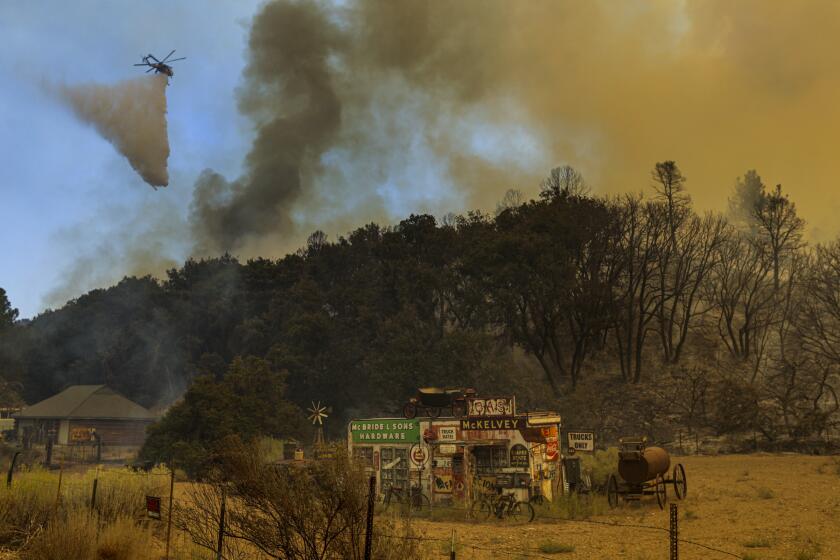Texas wanted armed officers at every school after Uvalde. Many campuses can’t meet that standard

- Share via
AUSTIN, Texas — A vision of armed officers at every school in Texas is crashing into the reality of not enough money or police as a new mandate took effect Friday, showing how a goal more states are embracing in response to America’s cycle of mass killings is proving unworkable in many communities.
Dozens of Texas’ largest school districts, which educate many of the state’s 5 million students, are reopening classrooms without meeting the state’s new requirements of armed officers on every campus. The mandate is a pillar of a safety bill signed by Republican Gov. Greg Abbott, who rejected calls this year for gun control despite angry pleas from parents of children killed in the Uvalde school massacre.
Texas has nearly 9,000 public school campuses, second only to California, making the requirement the largest of its kind in the U.S.
“We all support the idea,” said Stephanie Elizalde, superintendent of the Dallas Independent School District, which has more than 140,000 students. “The biggest challenge for all superintendents is that this is yet again an unfunded mandate.”
The lawsuit seeks damages in excess of $121 million for the cost of extinguishing the Bobcat fire and the resulting damage to property and natural resources.
The difficulties lay bare limits of calls to put armed guards at every school, more than a decade after the National Rifle Assn. championed the idea in the face of an intense push for stronger gun laws following the Sandy Hook Elementary School massacre in 2012.
The new Texas law allows exceptions and does not require districts to report compliance, making it unclear how many schools are meeting the standard.
But by all accounts, many are not.
The Associated Press contacted 60 of Texas’ largest school districts about whether they were able to start the school year in compliance. The districts, which cut across a wide swath of Texas, from rapidly growing suburbs to the U.S.-Mexico border, enroll more than 2.7 million students combined.
Not all districts responded and some declined to discuss staffing levels, citing security concerns. But statements to the AP, along with a review of school board meeting actions and statements made to local media, show at least half have been unable to comply with the law’s highest standard.
A major struggle is staffing elementary schools, where officers are traditionally less common. But those campuses came under calls for more protection after a gunman killed 19 fourth-graders and two teachers last year at Robb Elementary School in Uvalde — a tragedy in which the failures were not over a lack of police, who were on the scene within minutes, but the inaction of hundreds of officers once they arrived.
Local school officials say the additional funding Texas gave districts under the new law, about $15,000 per campus, is hardly sufficient. In Dallas, Elizalde said an extra $75,000 is needed for each additional officer in Texas’ second-largest district.
In the scramble to comply with Texas’ new standards, options some districts previously never considered are now on the table: Some are turning to private security firms or arming more teachers and other staffers.
“This is probably new to everybody at this stage of the game. It’s expensive,” said Charles Hollis, director of operations at L&P Global Security in Dallas, which until this year had not put guards at public schools. The company now has contracts with four booming districts and is in talks with four others.
In response to questions about cost concerns raised by districts, or whether Texas had enough officers to meet the intent of the law, Abbott spokesman Andrew Mahaleris said in a statement that the law allows for flexibility, including arming school employees.
“Governor Abbott will continue working with the legislature to expand school safety initiatives and ensure all Texas students can thrive,” Mahaleris said.
The combination of not enough money for officers, and not enough of them to fill thousands of openings across the U.S., is an ongoing struggle in cities nationwide. Last month, a small Minnesota town lost its police department altogether after officers resigned over low pay and pursued better opportunities elsewhere.
The national shortfall of officers has hampered other states’ attempts to patrol all schools.
Florida struggled in 2018 when the state became the nation’s first to require an armed officer on every campus after the shooting at Marjory Stoneman Douglas High School in Parkland.
In Tennessee, after an elementary school shooting in March, the state offered police departments extra funding to staff every school. But police in Nashville, Tennessee’s largest city, rejected most of the money.
“With the level of our staffing, we can’t pull 70 officers from the streets of Nashville,” Metro Nashville Police Chief John Drake told reporters in July.
Joy Baskin, education counsel for the Texas Assn. of School Boards, said all mandates come with a price tag. “But I think this is the biggest one I can remember in more than 25 years of talking to districts,” she said.
In San Antonio, the Southside Independent School District was able to start the year with enough officers, who make $23 to $30 an hour. Don Tijerina, the district’s police chief, said it wouldn’t take any of them long to find jobs elsewhere.
“Bottom line: The demand is so high right now,” he said.
More to Read
Sign up for Essential California
The most important California stories and recommendations in your inbox every morning.
You may occasionally receive promotional content from the Los Angeles Times.














